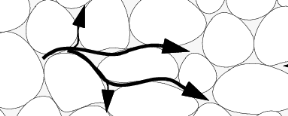The dispersion is controlled through the dispersion tensor DD. The tensor components can either be given by user-defined values or expressions or derived from the directional dispersivities.
In these equations, DDii (SI unit: m
2/s) are the principal components of the dispersivity tensor, and
DDji and
DDji are the cross terms. The parameters
αL and
αT (SI unit: m) specify the longitudinal and transverse dispersivities; and
ui (SI unit: m/s) stands for the velocity field components.
In order to facilitate modeling of stratified porous media in 3D, the tensor formulation by Burnett and Frind (Ref. 4) can be used. Consider a transverse isotropic media, where the strata are piled up in the
z direction, the dispersivity tensor components are:
In Equation 8-36 the fluid velocities
u,
v, and
w correspond to the components of the velocity field
u in the
x,
y, and
z directions, respectively, and
α1 (SI unit: m) is the longitudinal dispersivity. If
z is the vertical axis,
α2 and
α3 are the dispersivities in the transverse horizontal and transverse vertical directions, respectively (SI unit: m). Setting
α2 =
α3 gives the expressions for isotropic media shown in Bear (
Ref. 5 and
Ref. 6).
